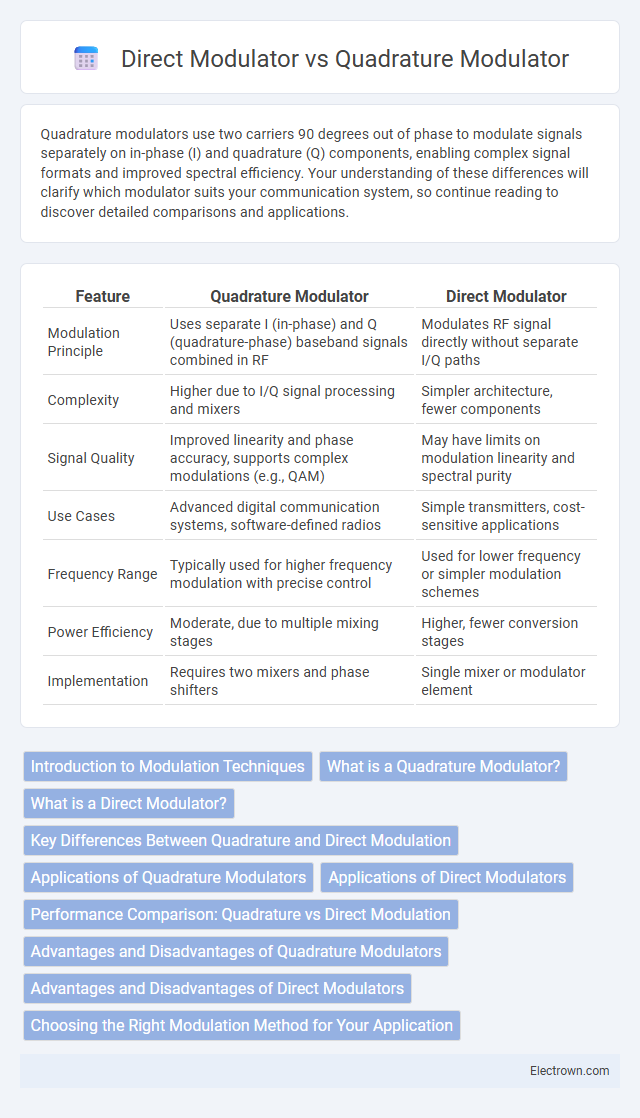Quadrature modulators use two carriers 90 degrees out of phase to modulate signals separately on in-phase (I) and quadrature (Q) components, enabling complex signal formats and improved spectral efficiency. Your understanding of these differences will clarify which modulator suits your communication system, so continue reading to discover detailed comparisons and applications.
Table of Comparison
| Feature | Quadrature Modulator | Direct Modulator |
|---|---|---|
| Modulation Principle | Uses separate I (in-phase) and Q (quadrature-phase) baseband signals combined in RF | Modulates RF signal directly without separate I/Q paths |
| Complexity | Higher due to I/Q signal processing and mixers | Simpler architecture, fewer components |
| Signal Quality | Improved linearity and phase accuracy, supports complex modulations (e.g., QAM) | May have limits on modulation linearity and spectral purity |
| Use Cases | Advanced digital communication systems, software-defined radios | Simple transmitters, cost-sensitive applications |
| Frequency Range | Typically used for higher frequency modulation with precise control | Used for lower frequency or simpler modulation schemes |
| Power Efficiency | Moderate, due to multiple mixing stages | Higher, fewer conversion stages |
| Implementation | Requires two mixers and phase shifters | Single mixer or modulator element |
Introduction to Modulation Techniques
Quadrature modulators employ two carrier signals shifted by 90 degrees to separately modulate in-phase (I) and quadrature (Q) components, enabling efficient bandwidth usage and improved signal fidelity in complex communication systems. Direct modulators combine baseband signals directly with carriers without intermediate stages, offering simpler architecture and lower latency suited for applications requiring minimal processing delay. Understanding the distinctions in signal processing and implementation complexity between quadrature and direct modulation techniques is crucial for optimizing wireless transmitter design.
What is a Quadrature Modulator?
A Quadrature Modulator processes two baseband signals, the in-phase (I) and quadrature (Q) components, by mixing them with cosine and sine carriers to generate a single complex modulated output. This method enables precise control of amplitude and phase, essential for advanced modulation schemes such as QAM and PSK. It differs from Direct Modulators by operating on separated quadrature signals before combining them, enhancing spectral efficiency and reducing signal distortion.
What is a Direct Modulator?
A Direct Modulator converts baseband signals directly into a modulated radio frequency (RF) signal without intermediate frequency stages, enhancing system simplicity and reducing latency. It integrates mixing and modulation into one step, unlike a Quadrature Modulator that separately processes I (in-phase) and Q (quadrature-phase) components before combining them. Understanding your system's needs helps determine if a Direct Modulator's streamlined design offers advantages in efficiency and size over the more complex Quadrature Modulator.
Key Differences Between Quadrature and Direct Modulation
Quadrature modulators utilize in-phase (I) and quadrature (Q) components to separately modulate and combine signals, allowing precise control over amplitude and phase for complex modulation schemes. Direct modulators alter the carrier signal directly in frequency or phase without separating components, often resulting in simpler hardware but less flexibility in modulation formats. Understanding these key differences helps you select the optimal modulation technique for your communication system's performance and complexity requirements.
Applications of Quadrature Modulators
Quadrature modulators are extensively used in wireless communication systems for precise signal generation in applications such as software-defined radios, digital TV, and LTE networks. These modulators enable efficient transmission of complex modulation schemes like QPSK and QAM, enhancing spectral efficiency and reducing interference. Your communication devices benefit from quadrature modulators by achieving higher data rates and improved signal quality in multipath and fading environments.
Applications of Direct Modulators
Direct modulators are widely used in high-frequency communication systems, such as satellite transmitters and radar systems, due to their simplicity and reduced component count. They enable efficient signal transmission by directly converting baseband signals to RF without intermediate frequency stages, minimizing latency and improving power efficiency. These characteristics make direct modulators ideal for applications requiring compact, low-power, and high-performance modulation solutions.
Performance Comparison: Quadrature vs Direct Modulation
Quadrature modulators excel in handling complex signal constellations and offer superior spectral efficiency by separating the in-phase (I) and quadrature (Q) components, resulting in lower phase noise and improved signal integrity. Direct modulators simplify the transmitter architecture by directly modulating the carrier wave, which can reduce hardware complexity and power consumption but may introduce higher distortion and limit modulation accuracy. Performance comparison highlights that quadrature modulation is preferred in high-data-rate and high-fidelity applications, while direct modulation is often favored for cost-sensitive or less demanding communication systems.
Advantages and Disadvantages of Quadrature Modulators
Quadrature modulators offer precise control over amplitude and phase, enabling efficient generation of complex modulation schemes such as QAM and QPSK, which is essential for modern communication systems. Their advantages include superior spectral efficiency and reduced signal distortion due to independent I and Q path adjustments, but they require careful calibration to mitigate IQ imbalances and phase errors that can degrade performance. Disadvantages include increased circuit complexity, sensitivity to component mismatches, and a higher design cost compared to direct modulators, which more simply modulate the carrier without separate I/Q paths.
Advantages and Disadvantages of Direct Modulators
Direct modulators integrate the modulation process by directly varying the carrier signal's amplitude, phase, or frequency, resulting in simplified circuit design and reduced power consumption compared to quadrature modulators. However, direct modulators often suffer from limited linearity and lower spectral purity, which can degrade signal quality and increase adjacent channel interference. Their susceptibility to LO leakage and amplitude mismatch also presents challenges for applications demanding high-performance RF signal generation.
Choosing the Right Modulation Method for Your Application
Quadrature modulators offer precise control over phase and amplitude, making them ideal for complex signal processing in communications and radar systems. Direct modulators simplify hardware design and reduce latency, benefiting applications where cost-efficiency and low power consumption are critical. Selecting the right modulation method depends on balancing system complexity, signal fidelity requirements, and operational constraints to optimize overall performance.
Quadrature Modulator vs Direct Modulator Infographic

 electrown.com
electrown.com